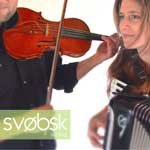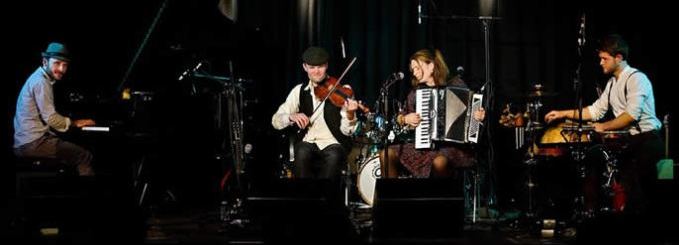On a fine May evening, at a big outdoor venue at a Canadian music festival, a concert is in full swing with the Danish quartet, Svøbsk, one of the most popular bands on the Danish folk music scene.
In the spotlight, down in front of the stage, singer and fiddler Jørgen Dickmeiss, and his wife, accordionist Maren Hallberg, are dancing. The whole audience look on, raptly attentive. The dance is a Sønderhoning, to a beautiful, slightly melancholy tune from the little Danish island of Fanø, off the west coast of Jutland. The music floats from the mouth organ Jørgen is deftly playing as he dances.
When the dance is over, applause bursts over them. The pair stand close together for a moment, then jump back to their places on stage. There, pianist Theis Langlands and percussionist Simon Busk are ready. As soon as they are regrouped, the band break into a couple of fast polkas. Playing jaw harp, fiddle, accordion, percussion and piano, they drive the music with a verve and pace that bring cries of delight from the audience, who clap along in time. There is magic in the air this evening!
A MUSICAL LOVE STORY
In central Denmark lies the hamlet of Davinde, some 12 kilometres from Odense. Odense, the largest town on the island of Funen, is where the poet and fairy-tale author Hans Christian Andersen grew up, and where the great Danish composer Carl Nielsen did his national service in the 16th Battalion's Regimental Band.
In downtown Davinde, home to around 400 souls, stands a newly restored farm house from 1780, half-timbered with black beams and whitewashed walls. To one side runs a bubbling brook and some neighbouring houses, to the other lie open fields. In this house live Jørgen and Maren with their 4 year-old son Alfred, and their 2 year-old daughter Selma, and this is their base.
"We started the Svøbsk duo in 2004," recounts Jørgen. "It actually began when Maren and I fell in love and soon afterward began playing music together. It was a "perfect match", so we chose the name Svøbsk, which is a fast dance where the dancers turn round and round and round until they are dizzy – "svøbsk" in Danish – and the giddy feeling is almost the same as when you are in love."
In 2005 Maren and Jørgen release their album Tell Me (Sig Mig), and in the years that follow they play hundreds of concerts of all kinds all over Denmark and abroad. The duo gradually build a name for themselves on the Danish folk music scene.
"You have to know each other really well if you want to catch the magic in the music," explains Jørgen. "I know that Maren is sitting right there beside me when we're playing, and we often succeed in catching the right magic. And when it doesn't happen, we both know it right away."
After a couple of years, Maren and Jørgen decide to expand Svøbsk with percussion and piano, a decision they have had no call to regret. In 2009 they make the album Timeless Sound (En Klang af Tidløshed), and these days you can hear Svøbsk as a duo, trio or a quartet. In 2011, the band played over 100 concerts. "We are very happy with this set-up. It's spreading like rings in water: more and more people are contacting us with offers to play at their venues and festivals. We are grateful for the opportunity to live the musician's life, playing together as a duo or with Theis and Simon."
THE UNFORGETTABLE CONCERT
Maren and Jørgen have taken their music abroad from the very start. Svøbsk tours in Germany, Sweden, Finland, Iceland, Scotland, Canada have shown that they have something different to offer, no matter where they go. Maren recalls in particular their very first tour abroad. It was to Greenland and lasted four weeks. They had prepared the trip carefully, even learning some traditional dance tunes from an old cassette tape of Greenland accordion music.

"We played many strange places and met lots of lovely people, but I remember one concert in particular. We were to play at a care centre for old folk in Narssaq in South Greenland, and when we arrived there they all were in their wheelchairs, old, senile and decrepit. But when we began to play the polkas we had learned from that old cassette tape, they began to smile and rock in their wheelchairs. One of the men even got up, dropped his crutches and began to dance with one of the smiling nurses. The staff later told us that the accordionist on the old tape came from the very settlement where the old folk grew up. The music brought back youthful memories and got the pensioners laughing and dancing in their wheelchairs. That was a beautiful experience that we'll never forget!"
THE TRADITION
Svøbsk have always worked with a calculated combination of traditional and newly composed folk music. Maren and Jørgen are very familiar with the tradition, which they use in their own fashion, while at the same time composing their own music, inspired by various styles and genres. "We are continually at work expanding our repertoire," says Jørgen. "The material comes from all over the country, because although Denmark is not a big country, we have a vast and varied musical tradition full of musical dialects.
Some of the tunes we work with are from the small islands, some we find played by old musicians out in the country, and others we find in old written collections. Our aim is to uncover the nerve and novelty of each tune, and while we consciously respect the tune's style and dialect, we work on the material so it fits in with our distinctive Svøbsk sound."
THE MAGIC IN THE DANCE
Both Jørgen and Maren are graduates of the Academy of Music and Dramatic Arts, Southern Denmark in Odense, and Maren's teacher, the Danish accordion master Carl Erik Lundgaard, would, as an integral part of her course, invite her to play with him on stage with his trio Lang Linken. For two years she played alongside her teacher while people danced to their music.
"It was the ideal way to learn! I love the traditional tunes, and I love playing for dancing, because that is what these tunes were made for. When you are playing a concert on stage it is naturally not the same as playing for dancing, but the vital thing to remember is that the magic in the tunes talks directly to the dancers' bodies.

Both Jørgen and I are fond of dancing and we like to give our audience a taste of the magic in the dance. We usually get down off the stage and demonstrate a Sønderhoning from the isalnd of Fanø, where they have a very strong folk music tradition. We dance alone the two of us, while Jørgen plays his mouth organ, and that is often a magic moment in our concerts. People sit with tears in their eyes. They say they can feel that we are inviting them into our music, to dance and sing and enjoy it all with us."
COMPOSING ASLEEP
When asked how they go about the work of composition, Maren comments that it is not always easy with two small children to mind, even though the children are a source of daily inspiration and often come on tour with them. The day before this interview, Maren had, for the first time for ages, some time at the piano, and it resulted in two tunes she is quite pleased with.
"For me, it happens when I least expect it," remarks Jørgen. "If I am trying out some new strings, for instance, or a new instrument, and playing something without thinking about it. Often it is nothing special, but other times I record it and let it lie for a few months. When I get time I come back to it and gather some of the fragments. It can be like a jigsaw puzzle – suddenly you have an a, b and a c-part that fit. In my case I have to try and forget that I am composing."
Maren breaks in, "It's wild when you wake up in the middle of the night, leap out of bed, grab your fiddle and play a brand new tune that you have dreamt."
"It's true," laughs Jørgen, "I think some of the tunes that have come that way are pretty good!"
The story of the Danish duo Svøbsk is an on-going tale of a journey with a musical project born in love, of a fascination with the tradition, of the joy of composing new music and of respect for the magic of music and dance. And it's all for the pleasure of a growing audience round the world, for example at a big outdoors venue at a Canadian music festival in the month of May.

English translation by Rod Sinclair.
Photo Credits:
(1)-(4) Svøbsk (from website).